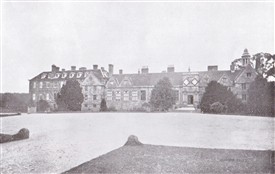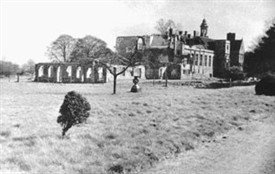Rufford Abbey

Rufford Abbey in 1903

Rufford Abbey pictured during the destruction of the north wing in 1956.
How a Notts jewel was saved from Destruction
(Building history: 17th century, early 18th century & 1830-40 by Anthony Salvin. Only monastic elements and outbuildings remain)
Country house visiting remains one of our most popular weekend pastimes and in the Dukeries area of north Nottinghamshire we are blessed with some very fine examples.
Although Welbeck Abbey is not open to the public, and Thoresby Hall is now an hotel, Newstead - the ancestral home of Lord Byron - and Rufford Abbey near Ollerton, home of the Savile family, are readily accessible to the weekend rambler.
Today these two great houses have become an essential part of Nottinghamshire's tourist industry, yet as recently as the Forties it looked as if one of them - Rufford - would be lost for ever.
During the second world war, Rufford was occupied by the military, who it was claimed, caused considerable damage to the fabric of the building.
The then owner, Mr Henry Talbot de Vere Clifton , proposed redeveloping the land for housing and wanted to demolish Rufford altogether.
Great concern was expressed locally and early in 1949, after much debate and discussion, an interim order of preservation was obtained by Nottinghamshire County Council.
Plans for demolition were still going forward when finally, in August 1949, the preservation order was officially confirmed and the building placed under the care of the Ancient Monuments branch of the Ministry of Works (now English Heritage).
In the following years attempts to find a new use for the house (such as a corporate or business headquarters) failed.
In the early Fifties it was acquired by Nottinghamshire County Council which continues to manage Rufford, together with the surrounding country park, on behalf of English Heritage to this day.
Restoration and Conservation since the 1950s
In the 50+ years since the abbey was saved considerable steps have been taken to consolidate and preserve as much of the original fabric as possible.
Two large wings - the 17th Century north wing and the 18th Century east wing - had to be demolished in 1956 owing to their being unsafe, but the visitor today is still able to enjoy the full panoply of the abbey's history from its origins in the 12th Century right through to additions made by its last great owners, the Savile family in the 19th century.
Origins and Dissolution
In the western range of the house, for instance, are the remains of the undercroft and the magnificently vaulted lay brothers' refractory from the time when, between 1148 and 1170, Cistercian monks from Rievaulx Abbey in Yorkshire first established an abbey at Rufford.
Though never particularly prosperous, Rufford remained in the hands of the Cistercians until the early 16th Century when, along with most other religious houses throughout the country, it was dissolved by Henry VIII.
The abbey, its farms and lands, were granted to George Talbot, 4th Earl of Shrewsbury, and it was under his successors - particularly the 6th Earl - that the abbey was converted into a country house: notably through the construction of the impressive west wing over the old Cistercian lay brothers' quarters.
By the early 17th Century the house was of sufficient grandeur for the 7th Earl to entertain James I and his son (later Charles I) at Rufford, the house serving as an excellent hunting lodge for sporting forays into Sherwood Forest .
The Savile family - owners for 300 years
In 1626 the Rufford estate passed by marriage to Sir George Savile in whose family (and that of the Lumley-Saviles) it remained for the next 300 years.
Further improvements were made and in 1679 the last remains of the north wing with reception rooms and a fine Long Gallery was added on the site of the old abbey church.
For Rufford, like so many other country houses, the 18th and 19th Centuries were a golden age of refinement and expansion.
In the early 1700s the gardens were laid out in the prevailing formal style with features such as the Broad Ride (originally lined with beech trees), the Bath House (an early example of a private leisure pool in England ) and ornamental canal, all still visible today.
Still further improvements were made by John Lumley-Savile who inherited the estate in 1835. He employed the noted architect Anthony Salvin (who also worked on nearby Thoresby) to design a new Tudor-style entrance porch with steps and a balustraded causeway, a clock tower, coach house, brewhouse and water tower.
Much of Salvin's work can still be seen today. When John Lumley-Savile died in 1856 the estate passed to his son, Captain Henry Savile, who was best known as an owner and breeder of racehorses, including the 1872 Derby winner, Cremorne.
Following the captain's death in 1881 the house was inherited by his youngest brother, Augustus William, and then, in 1887 by Sir John Savile, who converted the Bath House into a Winter Garden to display some of his collection of sculptures. Sir John Savile died in 1896 and was followed by his nephew who was known as a great socialite.
He loved to give lavish parties filling the house with guests, including Edward VII. As the new century wore on, however, and particularly after the First World War, it became clear that the old way of life at Rufford was about to vanish for ever.
When the 2nd Lord Savile died in 1931, his son and heir, George, was still a minor and by 1938 the problem of meeting rising taxes and wages, together with reduced income from farm rents forced his trustees into selling the Rufford estate.
It was initially purchased by Sir Albert Ball, a Nottinghamshire industrialist and father of the famous First World War flying ace and VC of the same name. Sir Albert sold off much of the estate in separate lots, the house and its immediate grounds being bought by Henry Talbot de Vere Clifton .
The rescue package of 1949, following the vagaries of the war, found the abbey in a pitiful state and in much need of repair.
Today, after over 50 years of renovation and conservation, however, Rufford has been re-born, becoming one of the county's premier tourists attractions.
It was designated a country park in 1969 and with its craft centre, art gallery, garden centre, historical exhibitions and restaurant, it now attracts 800,000 visitors a year.
See JACKS, Leonard The Great houses of Nottinghamshire and the County Families (Nottingham: W & A S Bradshaw, 1881) p.108
EDITOR'S NOTE For visitor information about Rufford Abbey click HERE